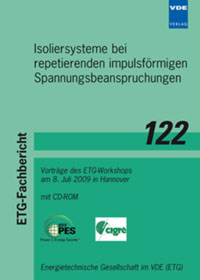Breakdown Strength of oil/Paper insulation systems at sinusoidal voltage stresses at higher Frequencies
Conference: Isoliersysteme bei repetierenden impulsförmigen Spannungsbeanspruchungen - ETG-Workshop
07/08/2009 at Hannover, Germany
Proceedings: Isoliersysteme bei repetierenden impulsförmigen Spannungsbeanspruchungen
Pages: 5Language: englishTyp: PDF
Personal VDE Members are entitled to a 10% discount on this title
Authors:
Nagel, M.; Leibfried, Thomas (Institut für Elektroenergiesysteme und Hochspannungstechnik, Universität Karlsruhe, Deutschland)
Abstract:
Despite the classic stresses on insulation systems, repetitive voltage pulses are more and more present in modern power systems. Their influence is yet quite unknown. Considering the large slew and repetition rates of HVDC valves with voltage-sourced converters, high frequency noise is generated and subjected to the insulation systems, e.g. oil and cellulose, used in transformers. For an assessment of the material properties of insulating materials, the breakdown strength is the most basic value needed. In order to be able to obtain those values for frequencies up to 400 kHz, with reasonable gap distances, an amplitude of 100 kV is crucial. The voltage should additionally be increasable from zero up to the breakdown, imitating the standard 50/60 Hz AC testing. In that matter, a test system was built for generating such kind of signals. For implementation a series resonance circuit was constructed, which is excited by a frequency variable inverter at the resonance frequency. Of special importance is thereby the optimization of the circuit itself to minimize losses and to increase the amplitude reachable. Not only the reactor was therefore specially designed, but the capacitive parts as well. Limiting for the last part, when e.g. thinking of standard test vessels for transformer-oil, is a minimum capacity needed for proper operation of the resonance circuit. Testing of insulation materials, concerning the breakdown strength against the high frequency voltages was done subsequently, as well as a comparison with standard power frequency values. Different influences on their behavior, like the moisture content of transformer-oil were investigated as well..


